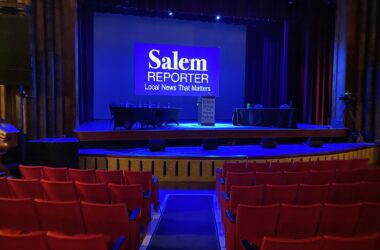A small purple and white plaque stands tall outside the Oregon Capitol, telling visitors about Oregon’s unique history of securing women the right to vote.
The Oregon Women’s History Consortium and the Oregon State Capitol Foundation unveiled the marker at the Oregon State Capitol State Park on the east side of the Capitol grounds Thursday.
“This moment teaches us about the precious fragility of liberties and rights and the necessity of all of us to continue this fight for equality,” said Kimberly Jensen, president of the Oregon Women’s History Consortium during her speech at the unveiling.
This marker was built as part of the national women’s suffrage centennial in 2020. It was then created and designed by the Oregon Women’s History Consortium with the National Votes for Women Trail to commemorate the groups of people who fought for women’s right to vote in Oregon.
“It is great to have it here so when people walk by they can stop and consider this history,” said Janice Dilg, one of the founding members of the Oregon Women’s History Consortium and current vice president and treasurer.
Salem’s plaque highlights the state’s unique suffrage history and the ratification of the 19th Amendment, which gave women the right to vote across the U.S.
“A diverse coalition secured voting rights for many Oregon women in 1912 & ratification of the 19th amendment here in January 1920,” it reads.

Members of the Oregon Women’s History Consortium decided what was going to be written on the maker. Their priorities were to distinguish that women in Oregon got the vote in 1912 — eight years before the 19th Amendment was ratified — and to highlight the diverse body of people who made it possible, said Dilg.
The unveiling date commemorates suffragette Susan B. Anthony’s July 6, 1905 unveiling of a Sacagawea statue at the Lewis and Clark Centennial Exposition in Portland.
Top women in Oregon and Salem politics attended the ceremony, including Oregon First Lady Aimee Kotek, Attorney General Ellen Rosenblum, Oregon Supreme Court Chief Justice Megan A. Flynn, Salem City Council President Virginia Stapleton and Councilor Micki Varney.
The struggle for women’s voting rights in Oregon began in 1870 according to the Oregon Secretary of State’s website. Equal suffrage associations fought for 42 years and brought the issue to the state’s ballot six times in 1884, 1900, 1906, 1908, 1910, and 1912, which was more than any other state.
On the sixth attempt, the men eligible to vote in Oregon officially extended the vote to women citizens in 1912.
The Oregon Women Suffrage Association, Chinese American Equal Suffrage Association, Jewish American Woman Suffrage, Everybody’s Equal Suffrage League, and Men’s Equal Suffrage Club of Multnomah County are some of the diverse groups that worked together in getting the vote for women in Oregon.
Black Oregon women were able to vote immediately, and many were involved in the fight for suffrage.
Oregonians Hattie Redmond and Katherine Gray co-found the Colored Women’s Equal Suffrage League, and advocate Mary Beatty, a Black woman, fought to get the vote in Oregon.
Indigenous and Asian women weren’t citizens under Oregon’s constitution and could not vote until later.
In 1920, Congress ratified the 19th Amendment which granted women the right to vote across the country and in federal elections. However, it wasn’t until 1965 that the federal vote was extended to Black women.
“Here I stand, a little over one hundred years later, standing on the shoulders of these courageous women, white and Black, who put their lives on the line so that we could have the right to vote and have a voice in the decisions about what happens in this state and in this country. For this I am extremely proud and grateful,” said Gwen Carr, a board member of the Oregon Black Pioneers, in her speech at the unveiling ceremony.
The national suffrage trail includes a database with a digital map and about 250 historical markers across the U.S., recognizing the diverse people and groups involved in the struggle for women’s suffrage according to the news release from the Oregon Historical Society.
The William G. Pomeroy Foundation and the federal Women’s Suffrage Centennial Commission have donated money to every state and territory in the U.S. to fund the markers. Each costs $1,100, according to Dilg.
Dilg said the Pomeroy Foundation donated enough money for 5 markers to be built in each state. Right now Oregon’s other marker resides in Pendleton.
Contact reporter Natalie Sharp: [email protected] or 503-522-6493.
SUPPORT OUR WORK – We depend on subscribers for resources to report on Salem with care and depth, fairness and accuracy. Subscribe today to get our daily newsletters and more. Click I want to subscribe!

Natalie Sharp is an Oregon State University student working as a reporter for Salem Reporter in summer 2023. She is part of the Snowden internship program at the University of Oregon's School of Communication and Journalism.









